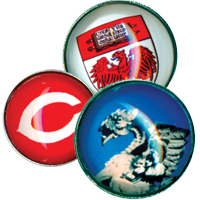 |
|
|||||||||
|
Or, how we got stuck on the idea of
magnetic icons. Then there’s the one that got away.
Right away we ran into problems. Our first-choice icon had been a no-brainer. Who wouldn’t want a one-inch, full-color, resin-domed replica of the Nobel Prize medal to stick on his or her refrigerator door? And what could be more Chicago than a Nobel Prize, especially in physics or economics? Unfortunately the Nobel e-Museum Web site’s Frequently Asked Questions list had anticipated our noble dream: “Q. I would like to request permission to use the Nobel Medals and Nobel Insignias. A. The Nobel Foundation is most restrictive regarding use of the Nobel Medals and Nobel Insignias.” In other words, no go. Like scholars around the world, you'll have to earn your medal the old-fashioned way. So we stuck with some images that are Chicago born and bred: a Cobb Gate gargoyle, the Maroon “C” (shared by those other Monsters of the Midway, the Chicago Bears), and the University’s phoenix seal. As they say on cable TV, these finely crafted items, in their own see-through plastic presentation case, “are not available in any store.” Instead the Magazine is offering the magnetic trio as a thank-you to readers who contribute $35 to help underwrite the Magazine’s annual production costs. We’ll happily accept larger gifts, of course; checks should be made payable to the University of Chicago Magazine, or you can make a contribution online (https://alumniservices.uchicago.edu/Giving/). Why there will always be
Chicago And Allen Zeyher, AB’90, writes, “[A]s an editor I have to point out what I think is a weakness of the Chicago Manual of Style. Mary Ruth Yoe wrote that the Manual ‘ranked No. 25 on Amazon.com’s sales chart (compared to Harry Potter and the Order of the Phoenix at No. 1).’ Several other style guides—including the AP Stylebook and Word Court by Barbara Wallraff—recommend that ‘compared to’ should be used when asserting a similarity. They recommend using ‘compared with’ to juxtapose two things primarily to show a distinction. I think this is useful advice, but I can’t find it anywhere in my 14th edition of the Chicago Manual. I don’t (yet) have the 15th edition.” We also pushed another Zeyher button: “Something that I find downright annoying is the popular overuse of ‘from…to’ phrases. I can understand how to get from A to Z. I can understand how to get from red to blue in the electromagnetic spectrum. But how do you get ‘from small-screen heroes to miniboat racers, from charity workers to circus performers’ (p. 50 of the August/03 issue)? The AP Guide to News Writing advises, ‘This construction denotes a logical progression, as from A to Z or from girlhood to womanhood, or from stock room to board room, or from soup to nuts.’ I can’t explain the ‘logical progression’ from soup to nuts, but in general I think they have a good point—a good point I can’t find in my 14th edition of the Manual.” Thus prompted, I tried the 15th edition’s online index. I didn’t find a “compare to/with” distinction, but I did see “compare with” used in other CMS rulings as Zeyher recommends. Mea culpa.—M.R.Y.
|
|
Contact
|


